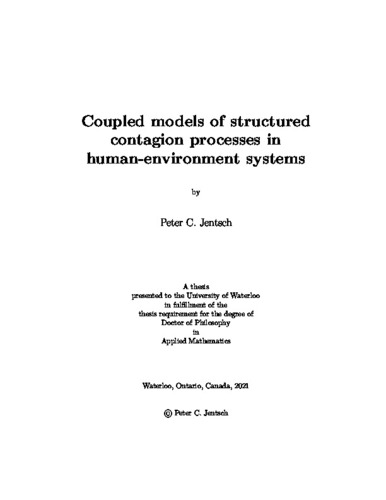| dc.contributor.author | Jentsch, Peter Carl | |
| dc.date.accessioned | 2021-09-15 19:01:24 (GMT) | |
| dc.date.available | 2021-09-15 19:01:24 (GMT) | |
| dc.date.issued | 2021-09-15 | |
| dc.date.submitted | 2021-09-08 | |
| dc.identifier.uri | http://hdl.handle.net/10012/17394 | |
| dc.description.abstract | Models of infectious processes are a common feature in the landscape of applied mathematics. It is rare that these processes are isolated from other significant dynamics in nature, and therefore we can incorporate some of the complexity inherent in real systems by coupling infections to major features of the ecosystems they inhabit. Infectious processes can take many forms, but in this thesis we consider three: the COVID-19 pandemic, the invasion of eastern North American forests by wood-borne pests, and the outbreak cycles of an endemic forest pest. The first chapter covers a model of Sars-CoV-2 in a structured population, coupled with a replicator equation representing sentiment towards the use of non-pharmaceutical interventions. We use this human-environment model of to compare the efficacy of vulnerable-first and transmission-preventing age structured vaccination strategies. The buildup of natural immunity in a population combined with a low vaccination supply is shown to cause a transmission-preventing vaccination strategy to be more effective. The second chapter considers a spatially structured model of forest pest contagion over an empirically-derived network of forest patches in eastern Canada. Since these pests can frequently be spread long distances by wood transport, we couple this model to the sentiment of local populations towards avoiding firewood transport from outside their area. Three possible countermeasures to the spread of the invasive pest are compared: social incentives, direct interception of infested firewood, and quarantine of patches. The level of effort needed to significantly reduce forest damage with any of these methods is substantial and unlikely to be implemented. The final chapter extends a model of mountain pine beetle (MPB) in western north american pine forests to incorporate tree mortality due to wildfire. We find that wildfire acts as a disturbance that increases the heterogeneity in age structure, and therefore is able to increase the resilience of the forest to outbreaks of MPB. A targeted thinning procedure aimed specifically at increasing heterogeneity in the forest age structure is proposed and shown to be highly effective at reducing the severity of outbreak. The effectiveness of targeted thinning in the manner described further emphasizes the importance of heterogeneity in forest stand structure. Each model tests the importance of indirect protection in preventing the spread of an infectious agent through a specific host population, with respect to key parameters. Models let us use counterfactuals to gain potentially invaluable understanding of these complex human-environment systems. | en |
| dc.language.iso | en | en |
| dc.publisher | University of Waterloo | en |
| dc.subject | human-environment systems | en |
| dc.subject | infectious disease | en |
| dc.subject | compartmental models | en |
| dc.subject | COVID-19 | en |
| dc.subject | forest dynamics | en |
| dc.subject | population ecology | en |
| dc.title | Coupled models of structured contagion processes in human-environment systems | en |
| dc.type | Doctoral Thesis | en |
| dc.pending | false | |
| uws-etd.degree.department | Applied Mathematics | en |
| uws-etd.degree.discipline | Applied Mathematics | en |
| uws-etd.degree.grantor | University of Waterloo | en |
| uws-etd.degree | Doctor of Philosophy | en |
| uws-etd.embargo.terms | 0 | en |
| uws.contributor.advisor | Bauch, Chris | |
| uws.contributor.advisor | Anand, Madhur | |
| uws.contributor.affiliation1 | Faculty of Mathematics | en |
| uws.published.city | Waterloo | en |
| uws.published.country | Canada | en |
| uws.published.province | Ontario | en |
| uws.typeOfResource | Text | en |
| uws.peerReviewStatus | Unreviewed | en |
| uws.scholarLevel | Graduate | en |

